Growing Onions in Containers
March 19th, 2021 | Categories
Growing onions at home in containers or pots is a great way to grow a nice crop of fresh onions when space is at a bit of a premium. What makes it even better is that growing onions in containers is a relatively easy process which means gardeners of all skill levels and experience can have a go. The particularly great thing about growing onions in containers or pots is that you aren’t actually planting in the ground, or even placing the container in a garden; they can be grown on balconies or other areas when there is little to no garden space.
Onions are one of the most popular and versatile vegetables in the UK. It might not be the most popular, a title reserved for the potato, but it’s sure up there, with millions being used or consumed on a daily basis in soups to salads or in sauces, and, of course, not forgetting the nations favourite fish and chip supper with a good pickle on the side. It’s no wonder then that it’s a very popular vegetable to grow among gardeners. There are quite a few varieties of red, white and shallot onions to choose from and grow that you’ll never see in the shops with their own delicious textures and flavour profiles. Most of us simply think ‘onions’ when doing the weekly shop, but there’s a lot more interesting choice out there that you can only get by growing your own.
If you want to grow your own onions in containers, then this guide will give you the information on what to do from the preparation to the tools needed, through to planting and on to harvest and storage. This guide will focus particularly on growing red, white and shallot onions in containers or pots at home anywhere suitable, from seed or set, so you know exactly how to achieve a good crop and harvest. We have covered how to grow onions in the ground in another guide, you can read it here.

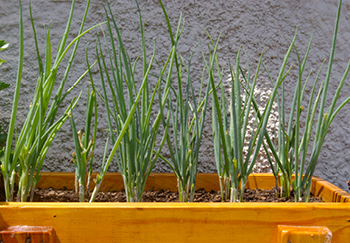
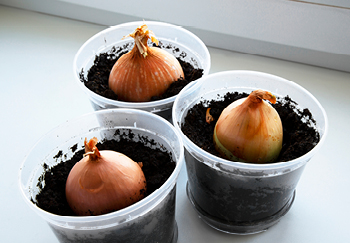
Why Grow Onions in Containers or Pots?
Growing onions in grow bags is a brilliant and easy way to grow onions at home when space is limited. And why choose onions you ask? Well, onions are unbelievably versatile vegetables and growing your own means you will have a supply nearby when you need them for your dishes. More than that though, onions form part of a balanced and healthy diet providing us a range of health benefits, vitamins, and minerals like vitamin C, B6, folic acid, as well as a good source of fibre. They are an immune system booster, they help to regulate blood sugar levels, and links have been found in studies that show onions can help regulate the body’s cholesterol levels. Onions have the added beneficial characteristic that they generally store well over winter. They’re also super easy to grow, and all varieties are grown the same way, meaning you don’t need to worry about any nuances in the growing process. Plus, we think you will agree that fresher is always better.

What Variety of Onions Should You Grow in Containers?
There are many varieties of onion across the brown, red or white types. Consider what types of onions you most enjoy, or specific use cases. Maybe you would like to pickle your own small white onions, or maybe you want to grow your own brown onions for sauces or red onions for a nice addition (and talking point) to those summer BBQ burgers and skewers. Or maybe you want to be a little fancier and grow deliciously sweet shallots. Whatever the use case and variety you’ll follow mostly the same process of growing.
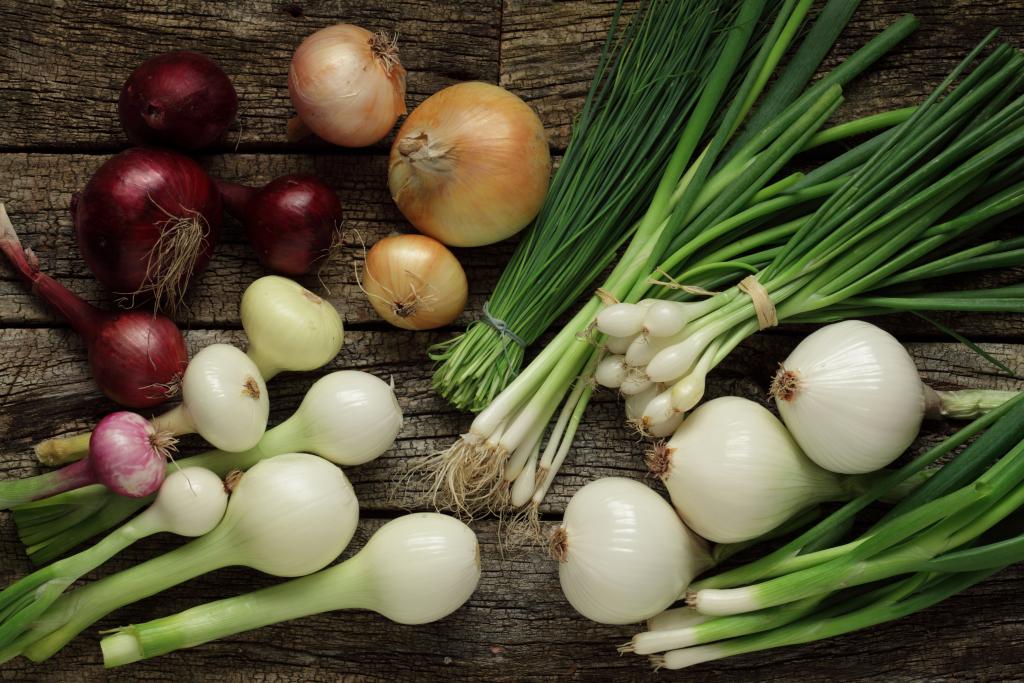
Varieties to try
If you’re a beginner, up until now you probably thought a brown or red onion was just a brown or red onion. UK supermarkets aren’t known for offering diversity across vegetables. An onion pretty much an onion. But with all vegetables, there are so many more varieties, and therefore choices, out there that you can only really experience if you maybe buy from a farm shop, or better yet, grown by yourself! From mild to medium to strong, sweet tasting, huge or small, there are so many more choices out there. This list below is just a small selection of the many varieties you can choose:
Globe Onions (brown)
A fine-looking variety that has a great smooth shape and rich brown skin. A reliable cropper and can grow exceptionally large (for an onion). It has a typical onion flavour and should keep for a long time if stored correctly.
Electric (red)
Lovely glossy red skins with an excellent flavour. Great eaten raw in salads and if you want longevity after harvesting it will last most of winter when stored correctly.
Golden Gourmet (shallot)
A lovely shallot variety with a white flesh that will generally produce a heavy crop. Good, sweet flavour and keeps well when stored.
Red Gourmet (shallot)
A typical round red onion with white and red lined flesh. Its flavour is mild which makes it suitable for salads and cooking. It was specifically bred from early red onions which means it will be ready for harvest a bit sooner than other onion varieties.
Red Sun (shallot)
A lovely shallot variety with a white flesh that will generally produce a heavy crop. Good, sweet flavour and keeps well when stored.
Zebrune (shallot)
A typical round red onion with white and red lined flesh. Its flavour is mild which makes it suitable for salads and cooking. It was specifically bred from early red onions which means it will be ready for harvest a bit sooner than other onion varieties.
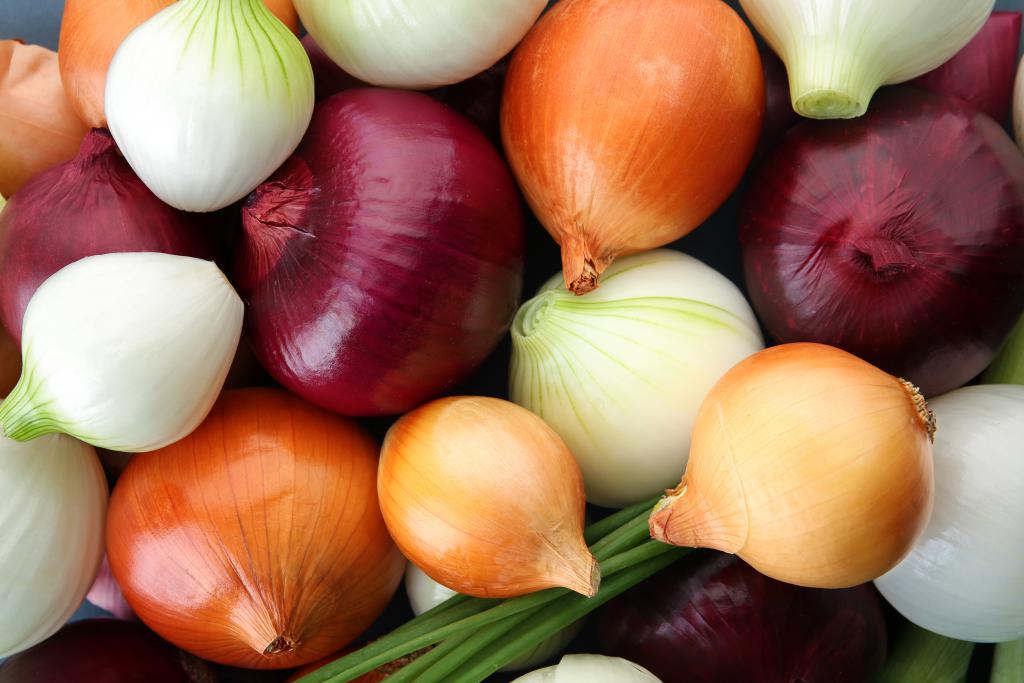
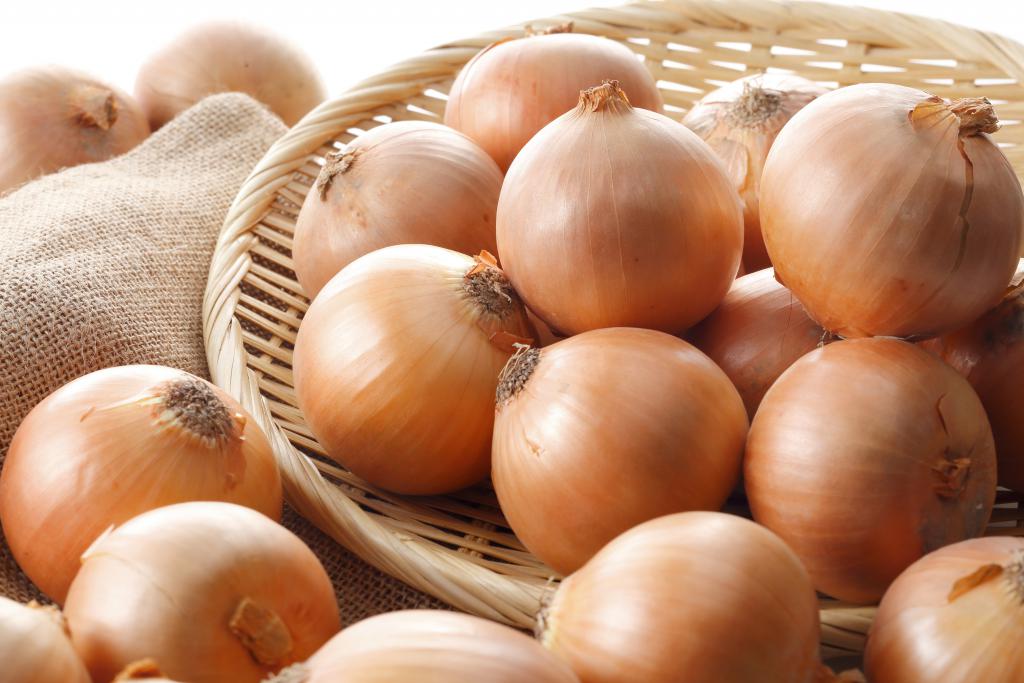
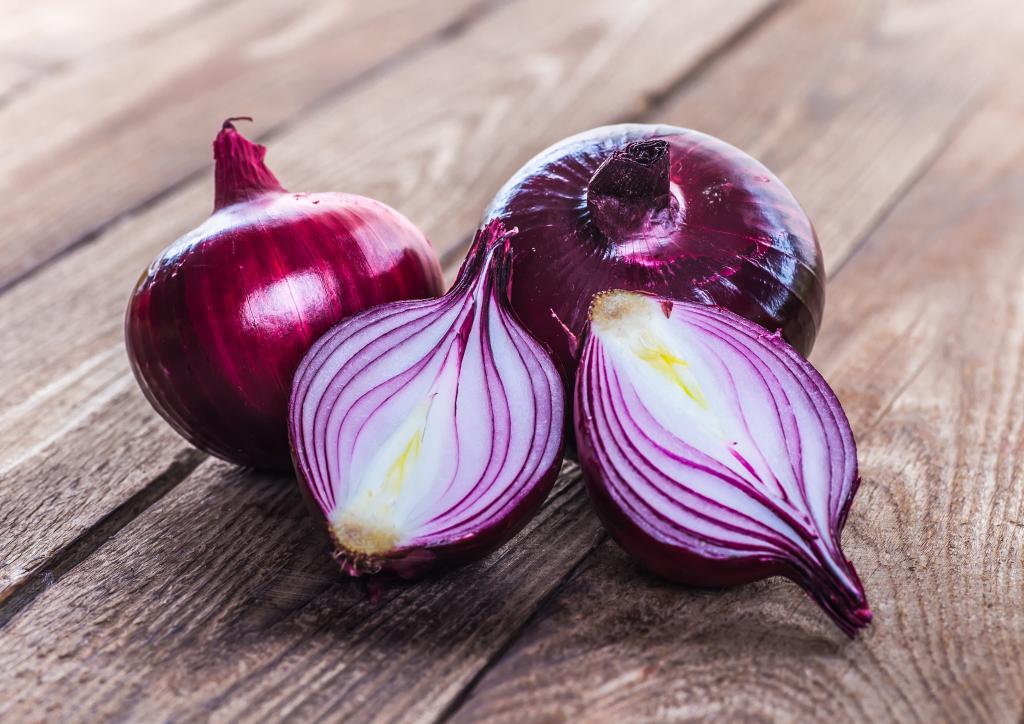



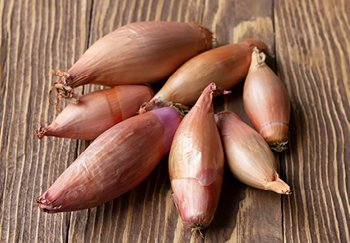
You Can Plant Old Supermarket Onions, But Don’t
Unlike some other store-bought vegetables which wouldn’t be suitable to use to start your crop, such as potatoes, onions can be used in this way. However, we don’t really advise it. Firstly, it’s boring. You get one choice at supermarkets so do you really want to grow more of the same? Heck no! Choose something new from the varieties above. Secondly, these types of onions are grown for their longevity at the expense of other qualities like flavour, texture and size. This is the same for any store-bought vegetables. Opt instead for organically grown sets or seeds from a good garden centre, use natural, good quality composts and fertilisers, and these, combined with the fact you will be able to pick and eat when fresh will make for a night and day experience.
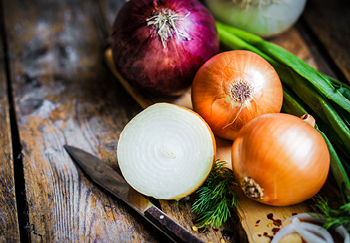
Choosing Seeds or Sets
Seeds are fairly obvious. Sets however are just baby onions. While growing from seed isn’t particularly difficult, set growing is the easiest and quickest way to grow them. If you want less time or hassle opt for sets. Sets are typically heat treated to kill their flower embryos which makes them far less likely to run to seed or bolt. This basically means for whatever reason the onion plant decides to try to produce and spread seeds instead of focusing on producing onions. Usually this happens because of the conditions or timings when growing. Say it is too cold, then they might think winter is coming and it’s time to produce seeds. Likewise, if the plants are suddenly stressed and could die, they’ll try to produce seeds quickly.
However, there’s a small trade-off to consider. While it may take a bit more time, growing from seeds allows for more choice of variety. You may find lesser choice when shopping around for sets alone as not all varieties are grown to be sold as sets. Growing from seed is also a good bit cheaper. If all you are really seeking is fresh onions without too much fuss about any specific variety, you’ll be fine with sets.
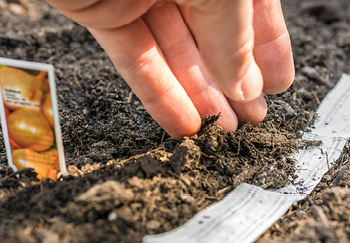
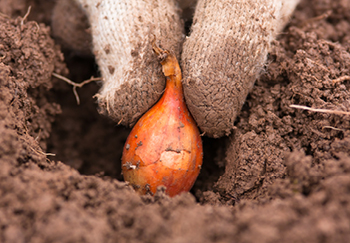
General Growing/Harvesting Timescale for Onions
When it comes to planting your onions in the UK in containers, it’s much the same as planting in the ground generally it will be around late March or April time. All going well, this will allow for harvesting around August. Please note though that some varieties will crop sooner so just be aware of the specific growing timeline of your chosen onion variety. Weather and growing conditions will also be factors to consider. If you are in a colder region of the UK on average, it might pay to wait a bit longer to plant which will influence when you can harvest. Since you’ll be growing in containers or pots, you might be growing indoors or have a greenhouse, then you will likely be able to plant sooner, and achieve a faster harvest. Consider all the factors and get a good idea of your plan ahead of time. As mentioned, some sets are sold as autumn sets, but we will be focusing on spring sets and spring planting in this guide. Please be aware though, if planting from seed you would begin the whole process while still in winter. We will detail what to do to prepare your seeds to give them the best start.
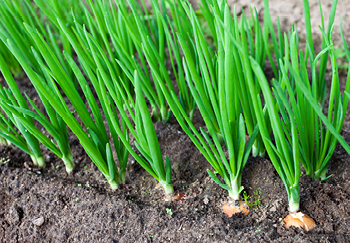
How to Start Growing Onions in Containers
Now you know some more about onions you’re ready to get started growing your own at home in containers. It pays to know what to do in advance so read through our guide, get up to speed, and then when you’re ready to go, get started! Remember, you’ll be starting off from seed or sets. Seeds are available year-round, but sets are generally available in spring.
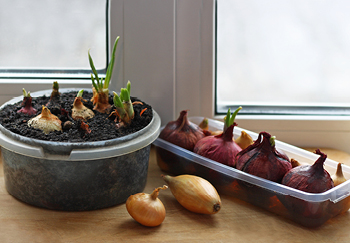
What You Will Need
Here are some key tools and items you’ll need to have to grow onions in containers:
Containers or Pots
Of course! A small container or pot won’t be suitable for growing onions although it may be useful for growing your seedlings if you are opting to grow from seed. For the growing of your onions, because you need several onions to get a decent crop, small pots are unsuitable for the task. If it’s a pot you want to grow them in, make sure it is large, approximately 30cm deep and a few feet wide. If it’s a container, typically you can find ones to suit in terms of size far more easily. Onions don’t have a deep root network so about 25 to 30cm deep is fine. Make sure it has drainage. Also, you’ll need multiple plants to produce a good crop, so this will in turn affect the size and or number of containers. Generally, the onions are grown in rows and the wider they are spaced from one another, and other rows, the larger they will grow. Placing them a little closer is OK, they will just produce smaller onions. Don’t crowd them with one another though. Aim for 10-15cm spacing on all sides.
Onions or Sets
Purchase your onion seeds or sets. More to come on this soon.
Compost
Your container needs a good quality compost, preferably one that is suitable for growing onions. A good quality general vegetable compost will suffice and it’s easy to find bags in any garden centre.
Fertiliser
Most composts will be full of nutrients at the start but as your onions grow, they will use them up, so a good nitrogen-rich fertiliser every so often will help to produce good yields and healthy onions.
Hand Fork
For digging and loosening the compost as you pour it into the container. The soil should be nice and loose to make it drain well and also to allow your onions to establish its root network.

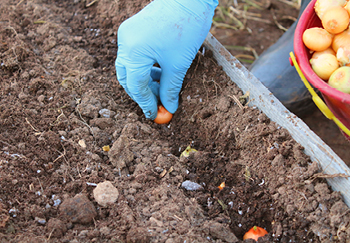
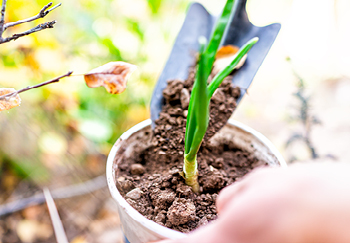
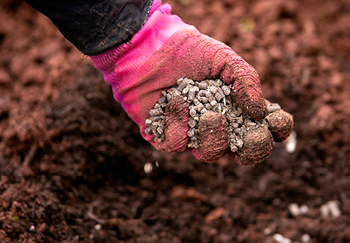

Growing Onions from Seed in Containers
If you are planting from sets, jump down to the next section. Now, when growing your onions from seed there are a few things to do before planting in the final container. For the best start, get a small tray or container, and fill it with a good quality compost. Then sow your chosen onion seeds into the tray or container for transplanting later when they become seedlings. Don’t overcrowd the seeds, but plant a few more than you think you may need to choose the best seedlings later. Top them off with a 1cm layer of potting soil. Then place the container on a bright windowsill, where the temperature does not drop below 15°C. Water with a fine spray until the soil becomes damp. In the coming weeks be sure to keep the soil damp but not overly wet. You will do this as many as 12 weeks before planting, so if planting in your container in April start it off in January.
When the seedings appear and the temperature is not only warm enough, but the nightly frosts have passed it will be time to transplant the seedlings into the compost in your container. Depending on where you are in the UK this will generally be sometime in April, maybe May if your area has slightly cooler average temperatures. At this stage you can remove any visually weaker looking seedlings to focus on the ones that will grow best and have the best chance of yielding a good crop.
If placing your container outdoors, to avoid shocking the seedlings – which can happen with any plant due to a change in environment – because they’ve been used to your comfortable windowsill for weeks now, harden them off for a week or two before permanently transplanting to your container. To do this, simply sit them in a sheltered position outside when the weather is fair. Naturally, you don’t want to do it when there’s heavy rain or high winds. Start off doing it for a couple of hours at first, increasing each the length of time each day, until they’ve been out for a full day.
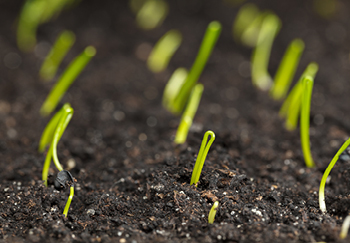
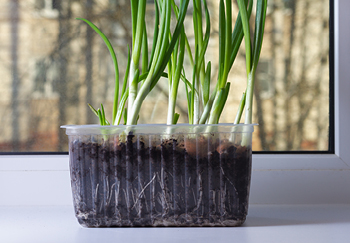
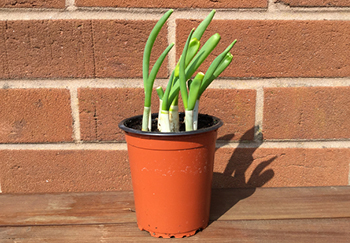
Growing Onions from Sets in Containers
We’re perhaps being a little cheeky giving this its own section, but if you opt to grow onions from sets you will simply purchase them when available in spring, then plant in your prepared container on your chosen site. Easy.
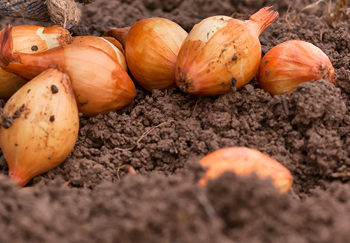
Consider the Site & Prepare the Container
Onions require a sunny but sheltered site with fertile and well-draining soil. Choose a suitable area. When choosing a spot for your container in the garden, patio, or balcony, it is essential that you place it somewhere it can receive about eight hours of sunlight. Only do this in spring when the risk of nightly frosts has passed and there’s a daytime temperature over 10°C. If you have access to a greenhouse then you will be able to do this sooner in the season so long as it is frost free.

Sowing Your Onion Sets or Seedlings in Your Container
When a suitable site has been chosen, and when the time is right to plant your seedlings or sets, start to prepare container by filling it with your compost, ensuring any clumps are broken up with your fork. The great thing about doing it this way is that there’s no ground prep like weed removal. Transplant the seedlings carefully by making holes into the compost deep enough for the roots. Then plant each seedling about 10-15cm apart in rows before gently firming in and watering. If you would like them to grow them a bit larger, try spacing slightly further apart.
It’s just the same process for sets, except here instead of seedlings you will simply, and gently, press your sets into the prepared compost ensuring the tip is just about showing. Firm the soil around them and water in well without over watering. Onions have a limited root system so it does pay to use some organic matter too at this stage if you can get it such as well-rotted manure. If not, a good fertiliser for onions or vegetables generally will work well. As mentioned earlier, the closer your seedlings or sets are will generally make for smaller onions. But you need a few plants for a good crop. Try to space them out in rows as best as you can to be able to grow five or six plants. You can always get a second container if you wish to grow more.
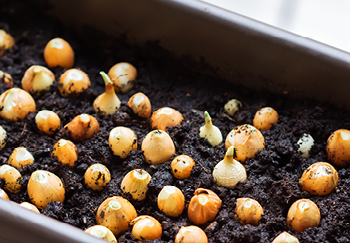

Growing
Water regularly as the plants grow, especially when the weather is particularly hot or dry. Be careful not to overwater though. Onions are not a particularly thirsty vegetable and will not like being over watered. If there’s heavy rainfall a protective cover might be an idea to protect them and keep the soil from waterlogging. Onions like a regular supply of nutrients but at a low level, so you don’t have to give them regular feeds of fertiliser. If you did do this, chances are you’ll just encourage them to grow more foliage and potentially flower at the expense of producing bulbs. Instead, fertilise sparingly once per month if at all. Cut off watering and fertilising when you see the onions have formed well. This will encourage them to mature further by developing thinner necks and firmer bulbs, which will help them to store better. Rest assured that most of the work has been done at this stage, and we think you’ll agree it’s quite straightforward. Keep an eye on your onions until it’s time to harvest.
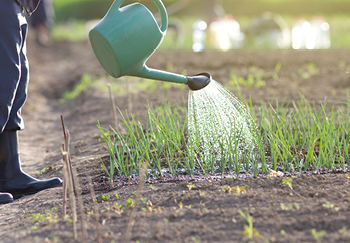
Harvesting your Onions
As mentioned earlier, when to harvest your onions will depend on your chosen onion variety, weather and growing conditions. Generally, though, spring-sown onions will be ready for harvest late summer to early autumn. You’ll know when it’s the right time to harvest because the leaves will droop and turn yellow to brown when they’ve stopped growing. At this point they should be big enough to use immediately if you like. To harvest, gently loosen the soil, a fork is best, and then lift the onions out. Allow them to dry somewhere such as an airy garden shed, greenhouse, or somewhere dry and airy, before storing as dampness can lead to mould and rot which will spread. The process of drying is called ‘curing’ and takes a couple of weeks. It will toughen the outer skin making it dry and papery, so it will keep for longer. Once dry remove extra top foliage.
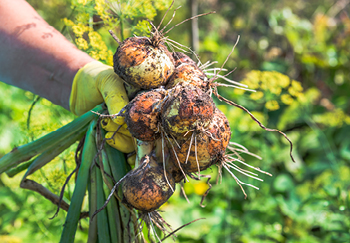
Storing Them
Store onions in nets, preferably suspended, tied into bundles or if you have the time and inclination woven into long strings. Depending on the variety and amount grown your onions should keep until at least midwinter, and some will keep as long as spring. Be sure to only store perfect undamaged bulbs. Grown well and stored correctly, they should last for months.

Common Problems to be Aware Of
Like any vegetable onions can suffer from some problems, but with the right preparation, care and attention you will have minimal issues. Here’s a run through of what to know and watch out for though:
Onion Neck Rot
When the soil is overly damp there is a chance that the onions will develop neck rot. It’s a fluffy grey fungal growth around the neck that in turn leads to softening of the flesh. The infected areas can dry out and turn transparent. This can be avoided by ensuring good soil drainage.
Onion White Rot
This is visible in the form of a dense white fungal growth around the roots and base of the bulb. Unfortunately, there is no cure or remedy, and the only real option is to dig up all traces then destroy them by burning.
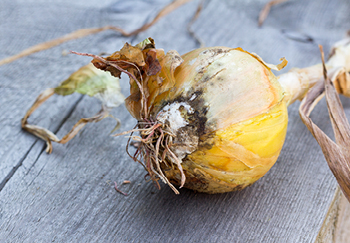
Slugs, Root Fly & Other Pests
Onions can suffer from bug infestations, slugs will eat them, but they are particularly enjoyed by root fly. The larvae of the fly eat the roots of the bulbs and may also burrow into them in late summer. Growing onions from sets reduces the problem. If you discover an infestation, remove infested bulbs promptly before the larvae move into the soil to pupate. If it gets too far the onions will have to be destroyed by burning and this site should not be used again. They can also suffer from infestation by thrips. If there’s a fine white mottling on the foliage it indicates their presence. They are tiny yellow or black bodied insects about 2mm long and are particularly troublesome in hotter weather. The damage they do to leaves results in smaller crops for harvest. There are a couple of decent treatments and remedies for thrips if caught early enough.
Splitting
If the soil is overly dry as they are growing onions can split or double which will reduce their ability to store well.
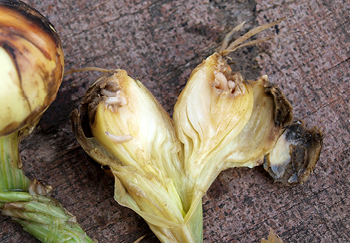
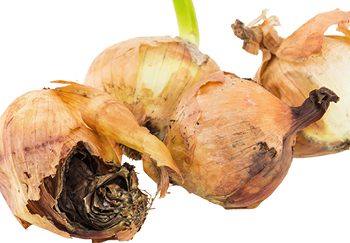
Your Very Own Home-Grown Onions from a Container
And we’re done! Just because you may have limited space shouldn’t limit what you want to try and grow. With this guide, you’ll be growing onions or shallots in containers in no time at all. Perhaps next time you can try a larger crop in a prepared part of the garden. Or, if you wish to grow other veg but space is at a premium try growing potatoes or tomatoes too. They and can be grown in an exceedingly small footprint and still be good croppers.
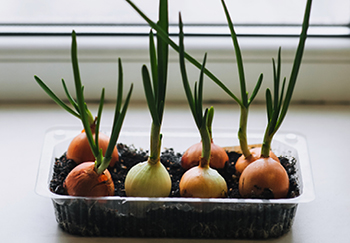
Useful Links
- Shop Online for Onion Seeds
- Growing Onions from Seed to Harvest (Article)
- Growing Potatoes from Planting to Harvest (Article)
- Growing Chillies from Seed to Harvest (Article)
- Guide to Growing Tomatoes in Pots (Article)
- Grow Your Own Herbs (Article)
- Grow Your Own Strawberries (Article)






